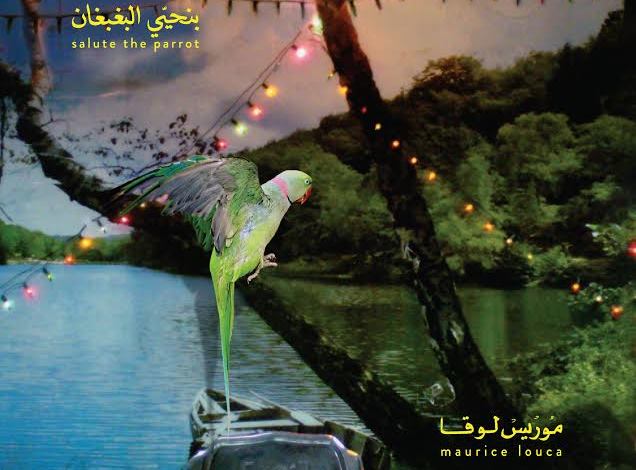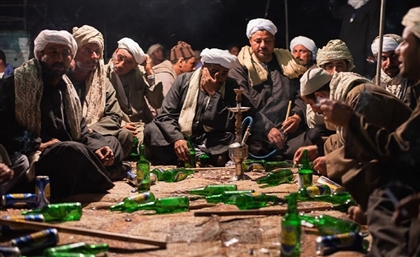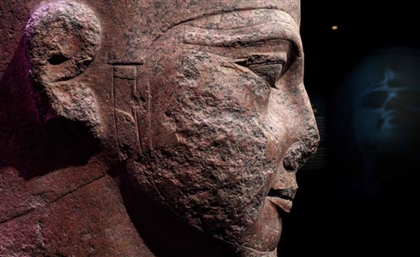Maurice Louca: Electro-Shaabi Reveries
Maurice Louca, one of Egypt’s most pioneering alternative musicians, has just released his second album “Benhayii Al-Baghbaghan” with Nawa Recordings. Kamila Metwaly reviews.

Two years in making, “Benhayii Al-Baghbaghan” (Salute the Parrot) lands as Maurice Louca’s most original work to date. In this work, Louca, having been exposed to an extensive variety of different music, is now confidently drawing on prior references to make this album into what it stands for today. Following years of collaborations and inconspicuous touring across Europe and the Arab world, Louca has become renowned for his powerful live shows. But those who have experienced earlier iterations of “Benhayyi Al-Baghbaghan” at one of Louca’s performances will hear an album that is far more complex and hard-hitting.
This eight-tracks Psychedelic-Shaabi album explores the culture of Shaabi. For Louca, the term “psychedelic” does not necessarily just reference his early musical influences, but also becomes a more ethereal visual journey of sound, “giving you space for visual imagination.”
Throughout the album, Louca is obviously inspired by Shaabi music,and how it captivates specific subcultural values. In Louca’s view, Shaabi music is “one of the most exciting” music genres Egypt and the Arab world has produced.
“Benhayyi Al-Baghbaghan” is a voyage between the charged intensity of confined spaces and the tranquil vastness of open landscapes. The album lays out a trajectory where beautiful and mesmerising fragments sparingly punctate the full-blown pounding episodes.
In some tracks, it feels like you are standing in the middle of Ramsis Square; sort of attacked by the massive sound pollution the square nurtures. There is a lot of sonic traffic; from its live music aesthetic, to the highly thought-out drum and percussion beats and patterns, to improvised Mawaweel by rababa, buzuq, saxophone, keyboards and electronically programmed synth-sounds. Only the consistency of the hard-smashing drums prevent you from getting lost, resounding in very strong sync.
The track Tassadou (Rupture) feels like a Zar performance, fused with a Mawal. The music is slowly introducing the ritual by Mohamed El Mahalawy, intermittently interrupted by a strong vocal sample from “Ana Wenta” by Ismail El Leithy that allows you to maintain your listening balance.
In the single Benhayyi Al-Baghbaghan, you are caught by yet another Mawal played on the rababa by Shaker Ismael. The very robotic vocals somehow feel like Louca’s intention was to experiment with street music and intuitive composition.
One of my favourite tracks on the album is Al-‘Asr Adh-Dhahabi (The Golden Age). Its live production aesthetic takes you to a Shaabi wedding in which you are accompanied by a continuing melodic improvisation played by Mohamed El Mahalawy on his keys.
When I asked Louca if Shaabi was an intentional choice for “Benhayyi Al-Baghbaghan,” he told me that he "didn’t want to release a Shaabi record because he pre-thought about it," yet his personal admiration for Shaabi music has highly influenced this process. The songs on this record are Louca’s own response to a new cultural phenomenon, paradoxical subcultures, and the microcosmic soundscapes found in Egypt.
Unlike his first solo album “Garraya”, this album is an acoustic realisation of composition, production, and a linear representation of soundscapes. Rather than making his experimental work a creative challenge, and his traditional work a ‘beautiful’ work, Louca works within both worlds in “Benhayyi Al Baghbaghan”. “Benhayyi Al Baghbaghan” is far more outspoken than “Garraya,” released by 100Copies in 2011, whereby Louca cemented his early sound, and then pushed himself far beyond its constrictions with his current release.
The most admirable aspect of Louca’s approach to making of this album is how true he was to the existing form of Shaabi music.
Louca also collaborated with the visual artist Maha Maamoun to create a visual representation of “Benhayyi Al-Baghbaghan,” whereby Maamoun explores the different ways in which mainstream images are re-appropriated. The album art comes in three different variations, whereby the nuances portray the paradoxical effect of Cairo's existing subcultures.
The album will be available on CD, 12” LP (black and limited edition green vinyl), and digital download. Pre-orders will be available via iTunes and the Nawa Store from October 10.
You can download the lead track, Al-Mashoub (Idiot) on Soundcloud.
Check out Maurice Louca on Facebook here.
- Previous Article Jumia Takes You to Paris!
- Next Article Nomades Land
























